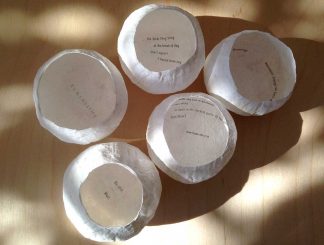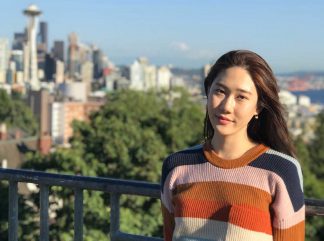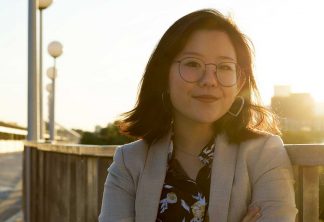By Allison Campbell-Jensen
Where would be the right place to show the “Interfaith Prayer Wall,” a 6 x 9 foot artwork by Aimee Orkin that incorporates works by the 18 other Interfaith Artist Circle artists collected in the exhibit “Visual Prayer”?
Initially, Deborah Ultan, Arts & Design Librarian, thought it should be displayed in Wilson Library. Its content would be appropriate, as Wilson holds the arts and humanities collections, including religious studies and most of art history.
Yet, as she discussed displaying the Interfaith Prayer Wall with Orkin, they began to lean toward a different context: the Architecture Library on campus, which has an impressive front wall.
“I was thinking about all the different architecture for all the different religions and how to put it on one wall,” Orkin says. “I wanted to create a space where all the artists in our group could be together, while still retaining their own faith and their own history — and wanting there to be connection.”
And the space could be interactive, Ultan says.
“I wanted to have a part where the students, too, could write a prayer and add it, like the Western Wall in Jerusalem.” As Ultan saw it, “The Interfaith Prayer Wall” would fit well there because in architecture people often talk about space and the sacredness of space. Orkin had conceived the visual prayer idea and for two years led study groups on the topic.
Ultimately, however, the COVID restrictions narrowed the “Visual Prayer” exhibit’s right place to virtual space.
The place
“The arts lift up our souls, they allow us to explore areas of ourselves that lie in a deeper place.”
—David Jordan Harris
Yet virtual spaces are not all the same. David Jordan Harris, the Interfaith arts special consultant for the Jay Phillips Center for Interreligious Studies at the University of St. Thomas and the Jay Phillips Center for Interfaith Learning at Saint John’s University, saw an online version of “Visual Prayer” hosted by a local Jewish community center. It was clean and handsome — but it also felt detached.
“In my work at the Jay Phillips Centers, I’m given free rein to present performances and exhibits that embody the dialogue between artists from different faith traditions,” he says. This exhibit’s subject and approach were promising; when he saw it, Harris says, “I thought, ‘Bingo!’” Orkin’s “Interfaith Prayer Wall” artwork now is on display at the Hoedeman Gallery of Sacred Art at the University of St. Thomas. But how could the “Visual Prayer” online exhibit be transformed from detached to conveying that excitement?
He approached the Interfaith Artist Circle and ultimately became co-curator of the exhibit with Ultan, who wanted interactive elements for the online audience. She introduced Harris and the artists to a few digital platforms, including ArcGIS StoryMaps, which the U’s Digital Arts, Sciences, and Humanities had been using for class projects. “It was the most flexible and the least linear of the choices,” Harris says. DASH Director Ben Wiggins recommended to the curators two DASH student employees, Chae Hong and Alyssa Miller.
The transformation
Using StoryMaps for something not based on maps was fairly new for Hong and Miller, as they envisioned how to make this exhibit more dynamic and engaging. “It was a pleasure to be a part of the exhibit design and to learn more about the individual artworks, as someone who considered studying visual arts for a long time,”Hong says.
They experimented with several options, mocking them up for Ultan and Harris — a time-consuming process. Fortunately, Ultan had told Harris, Orkin, and the other artists to expect a learning curve. “It hadn’t been used on an art exhibit per se yet,” she says.
Miller credits Hong with “a very ingenious, aesthetically pleasing way to present the work by using a slider. One side of the slider shows the artwork and the other overlays the art with a semi-transparent white that holds a description of the work.”
While putting all the artworks in one StoryMap, however, Hong and Miller found to their dismay that the platform was trying to lower the quality of the artworks and videos accompanying them so that everything would fit. They had to begin again, using several StoryMaps to build the one exhibit. Yet those limitations became the opening to something new: an organization around themes.
The curators, Harris says, “were obliged to create rooms that allowed us to interpret the exhibit in ways we wouldn’t have foreseen before. Those six rooms are Blessings, Meditations, Passages, Petitions, Songs of the Earth, and Teachings. I think the artists are kind of thrilled with it.” In this new organization, the designers could even add creators’ statements, credits, and a table of contents.
The transformed exhibit
“We were able to position the artists as if you were walking from one gallery to the next. … That was a real ‘wow’ moment.”
—Deborah Ultan
Like Matisse’s poor health leading him to trade paint brushes for scissors, resulting in his famous cut-out artworks, Harris says, this adaptation began a new chapter. “What does it mean to really meet this art head-on?” He says they could “keep the artistry and the inquiry that is part of artmaking.”
The transformed exhibit excites Ultan because it allows the artworks to talk to each other.
“We were able to position the artists as if you were walking from one gallery to the next. We started talking about the artwork differently, because we were able to engage it with its content and its texture, the way you would be doing with a real exhibit,” she says. “That was a real ‘wow’ moment.”
Artist Orkin first showed her “Interfaith Prayer Wall” piece in Jerusalem, where it captured the attention of some Muslim college women excited to see the incorporation of Islamic art and brought their siblings to see it. With this online exhibit, too, she would like to develop more connections among people. In addition, she says, “my hope is to also inspire creativity and a chance for people to feel more comfortable with prayer and making a space for prayer.”
Provoking conversation, especially among those who might not typically visit an interfaith exhibit, is one of Harris’s goals. “Because frankly, given the world that we live in right now, every single person should be in that conversation.” He adds: “The arts lift up our souls, they allow us to explore areas of ourselves that lie in a deeper place.”
Finally, exhibits like these give students, faculty, and the community reason to pause and engage with something intellectually stimulating or visually exciting, Ultan says. “They’re not just running into the Libraries to grab a book, do a search on the database,” she says, “but they actually recognize that this is a place of intellectual and spiritual pursuit and curiosity.” And the interfaith aspect engages viewers with the idea of diversity, Ultan says, which the Libraries take very seriously.
“It’s now time for the most important part,” Orkin says, “getting students and professors and the community involved.”
Donor support makes a difference
The RA salaries for Alyssa Miller and Chae Hong have, from the beginning, been paid by Libraries’ donors Darby and Geri Nelson. Thank you, Darby and Geri!







